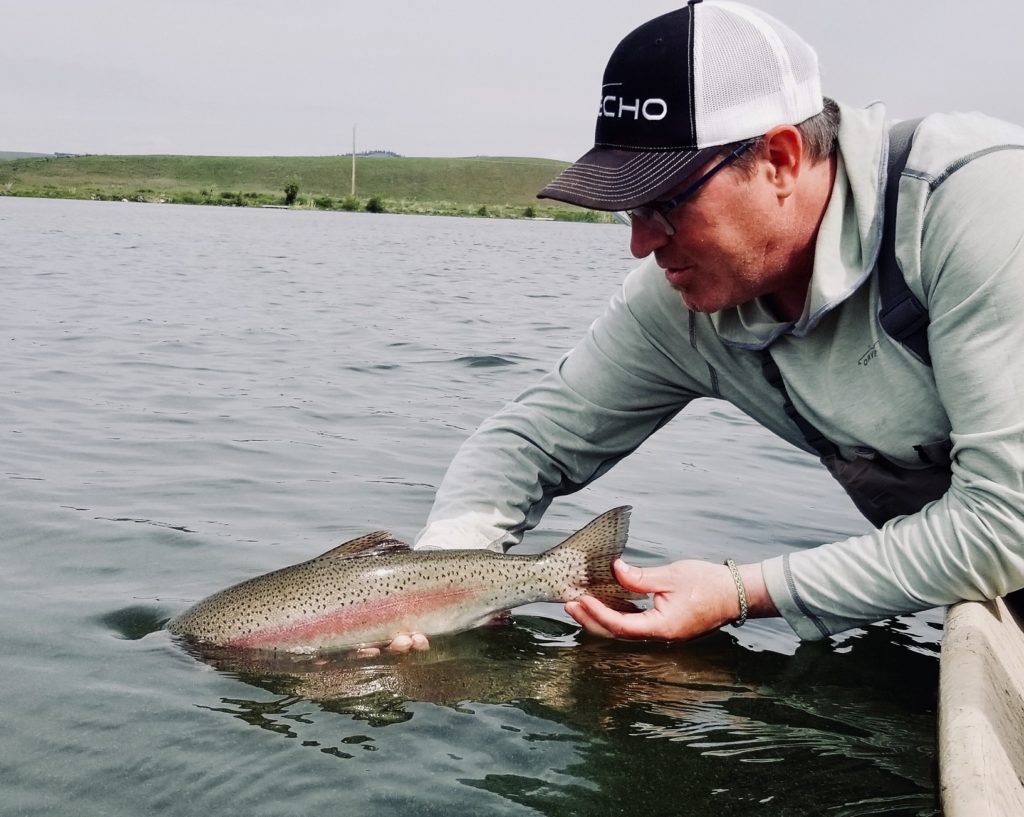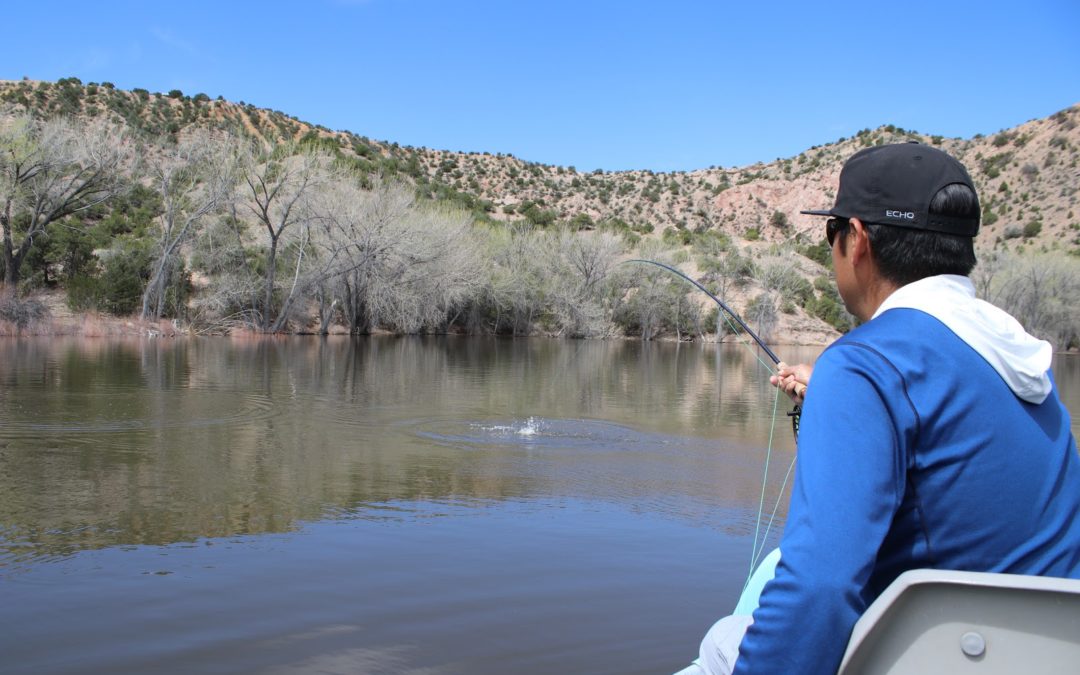A Quick Overview into a Deep Underworld ~
Lake fishing. Trout fishing’s most boring scion. At least that’s what I thought until I tried loch style fly fishing, and I’ve never been so happy to be wrong in my life (you ruined me, Norm). Don’t get me wrong, I do enjoy fishing chironomids and balanced leeches under bobber rigs, but the fast paced nature of loch style is a natural compliment to my ADHD.
What if I told you that instead of doing whatever it is that you do during run-off, you could turn a lake into a river and fish the never ending streamer drift? There aren’t too many applications in the trout fishing world where you want to cast as far as you can, but loch style is one of them. Yes, anglers that Euro nymph can actually double haul. So what is loch style, what do you need to get started and how do you do it? Follow me below and you’ll be poppin’ and lochin’ in no time at all!
What loch style means –
Loch style comes from our fly fishing forbearers across the pond in the UK. It is extremely popular over there, as the most easily accessible fishing for the average angler is stillwater. Basically loch style boils down to kicking your boat perpendicular to the wind and fishing down wind of the boat as it drifts…the opposite of trolling. By fishing down wind of the drifting boat you touch fish that haven’t yet been run over by said boat and you’re always presenting your fly to “fresh fish”. You can deploy a “drogue” (drift sock in ‘Merican English) off the gunwale to control the drift speed and use a myriad of different leader formulas and lines to control where your flies are presenting in the water column.
Boat –
First and foremost, you will need a boat, although you can certainly fish loch style from a float tube, kayak, personal pontoon, etc. If you have one, your drift boat will work fine for this application depending on the type of drift boat, size of the lake and conditions. Using a trolling motor will make your life a lot easier and in larger, windy lakes a necessity, especially when you need to make it back to the ramp ASAP. I wouldn’t know though because my Dad is Hercules and my arms are made of titanium.
Know your limits, know yours and your boat’s capabilities, and triple check the weather. Across the pond the Collum 15 and Irish Sheelin boats dominate the scene. In North America the serious stillwater folk will run jon boats with V and modified V hulls so they can deal with a myriad of conditions.
Drogue (Drift Sock) –
For light winds a drogue isn’t necessary but you will definitely want one when the wind picks up. Having the drogue properly deployed will keep the boat moving at a manageable speed. You can also vary the position of the drogue to dial in a perfect drift.
Loch Rods –
The 6100 (10ft 6wt) seems to be the what most practitioners of loch style lean toward. I must say I love my Echo Ion XL 6100! It’s an absolute joy to cast regardless of the conditions. The longer rod makes fishing long leaders more manageable especially when fishing the techniques like a “hang”. A 6wt is a crowd favorite because you want a rod that can handle a large grain window and a bevy of sinking and floating lines.
One of the most fun parts about loch style fishing is the casting! I said it. There aren’t too many practical applications to throw 80ft casts for trout. This is one of them.
Loch Lines –
Airflo’s very own Gareth Jones (The Lake Jedi) has helped design arguably the best still water lines on the market. Notice me Gareth. If you look at what the top still water competitors around the world fish, they most likely have a few Airflo lines in their kit. I say a few because you’ll probably want to have a couple of lines to match where the trout are in the water column.
I really love the Airflo Sixth Sense Fast Intermediate line for most of my lake endeavors. Next up on the list would be the Airflo Sixth Sense Sink 3 (3ips sink). There’s not a ‘one size fits all’ scenario for choosing a lake line. Most of the lakes I fish aren’t very deep and most fish seem to be taken in the first 10ft of the water column, making the fast sink intermediate a great fit for the locales I fish. Some lakes have excellent dry fly fishing opportunities as well, so don’t forget to have a floater with you, just in case.
Flies –
Fun fact: over in the UK, streamers are referred to as lures and stripping is referred to as pulling. But we’re not in the UK and I know if I refer to stripping streamers as pulling lures, a bald eagle will never learn how to fly. We don’t want that now, do we? A few other Loch (lake) vocabulary words are buzzers (chironomids), team (multiple flies), and “cracking”. I assume cracking is our equivalent of “sick” or “dope” because all the Airflo UK guys say it to each other when a nice fish is landed.
Loch style is the act of drifting with the wind at your back, covering water from a drifting boat. Being a technique, you can adjust your files and how you fish them according to your line choice and prevailing conditions and trends. You can crawl teams of chironomids back as you drift or even just strip in slack to keep up with the boat, fishing them on a drop or static. You can fish a mix of floating and weighted flies, unweighted, dries…the list goes on and on.

Overview –
Loch style fishing is a fun and exciting way to experience stillwater fishing. The ability to turn a lake into the never ending drift, make long casts and cover lots of water keeps the day engaging and dynamic. If you have some trout stillwater opportunities available to you, don’t miss out. I know you’ll rethink what still water has to offer you. Are you ready to pop and loch??
~ James Garrettson is a member of the Echo Fly Fishing and Airflo USA Pro Team. He found love for the brook trout in Virginia’s Blue Ridge Mountains and soon after getting a driver’s license, he could be found fishing for anything that could swim from New York to Florida. After bouncing around Utah, Costa Rica and Washington State, James has found a home in Northern New Mexico. From the small trout-filled creeks, the technical San Juan and The Rio Grande, New Mexico offers the angler excellent trout fishing year round.
James guides for About Trout, located in the heart of Northern New Mexico. When not guiding or fishing, James spends his time with his beautiful wife and kids, or fishing or both! www.abouttrout.com

Recent Comments